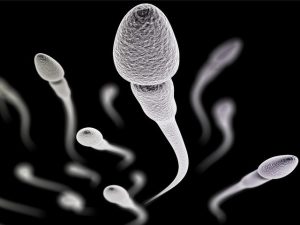A male orgasm is the culmination of coitus (sexual intercourse), the peak of sexual arousal that ends with the release of sperm. It is accompanied by rapid pulse rate, increased blood pressure, pelvic muscle spasms, which cause urethral contractions and ejaculation.
An orgasm can occur during sleep and dreams, sexual intercourse, or masturbation.
Male orgasm, physiology
In general, not much is known about the orgasm and over the last century the theories about it and its nature have changed dramatically. When a man is sexually aroused, friction against the head of the penis and other stimuli send signals through the nervous system that lead to ejaculation.
At the moment of ejaculation, the walls of the testicular appendage contract, creating peristaltic waves that push semen into the ejaculatory duct. Nerve impulses also stimulate contraction of the seminal vesicles and prostate, resulting in sperm (a mixture of sperm and secretion) entering the urethra.
The muscles surrounding the urethra push the sperm out of the penis. To keep the sperm from entering the bladder, the bladder neck is compressed.
Ejaculation occurs in two phases:
- The ejection phase. Semen moves from the testicles and testicular appendage (where the spermatozoa are stored) to the beginning of the urethra. It is a hollow tube through the penis through which sperm or urine is transported.
- Ejaculation. Semen moves through the urethra and is expelled from the body.
Stages (stages) of reaching the finish

Orgasm is important for human health, during it hormones and BAS (biologically active substances) are produced. Activates the process leading to the sexual finish, the male hormone testosterone, constantly produced by the testicles.
In addition to the hormone, the testicles produce millions of sperm cells every day. They mature and then mix with a protein-rich secretion, seminal fluid. This secret nourishes, sustains the sperm cells. Therefore, they are able to live after the release of semen, outside the body, for a while longer.
The mixture of seminal fluid and sperm is called semen. Moving through the urethra, semen is ejected from the penis during the finish.
Sexual intercourse can be divided into stages:
- Sexual arousal. Precedes intimacy. The man perceives something or someone that arouses sexual interest. This perception prompts the brain to send a signal through the spinal cord to the genitals, causing an erection. The penis enlarges, becoming tight as blood fills the cavernous bodies in the penile shaft. The inflow of blood at such a moment prevails over the outflow. The veins of the penis are compressed so that more blood remains inside, causing a solid erection.
- Preparation for the discharge of semen. Lasts from 30 seconds to 2 minutes. The tension of the muscles increases, the friction speeds up. A clear fluid begins to flow out of the urethra, designed to change the pH balance in the urethra to increase the chances of sperm survival. The orgasm itself consists of two phases: ejection and ejaculation. Semen accumulates at the top of the urethra, ready to be ejected. Ejaculation occurs as a result of a series of rapid contractions of the penile muscles. The nerves that induce the contraction of the muscles send impulses to the brain and the hormones of joy and pleasure, endorphins, are released.
- Refractory period. After ejaculation, the penis loses its erection. Muscle tension subsides, the man may feel relaxed or sleepy, the refractory period begins. This period varies in men of different age groups. In 18-year-olds it is less than 15 minutes, in older men it is 10 to 20 hours. The average refractory period in a young, healthy and active man is about 30-40 minutes.
Men differ from women in that they are usually satiated after one finish. Women can experience more than one satisfaction without losing sexual arousal, they do not need to go through a refractory period.
Male discharge options
Reaching climax in sexual intercourse can be done in different ways. Depending on the relationship between the partners, different options for male sexual discharge are possible.

Physiological variant
The ending of coitus can be with ejaculation, without ejaculation and with ejaculation with minimal sensations.
- The physiological finale without ejaculation is the so-called dry finish. Often the partner intentionally does it to prolong the frequency of intercourse, to get more pleasure.
- Ejaculation with minimal sensations is a state in which semen is ejected, but the sensations are not so bright and colorful due to weak passion for the partner, or due to lack of stimulation.
The male organism is not as simple and “primitive” as it seems to many people. Just a “boner” is not enough. Not only the penis of the man needs stimulation, but also the erogenous zones – nipples, neck, anus.
Psychological variant.
Occurs in men who take pleasure and bring themselves to the finish line, from watching adult movies, peeping, extremes, etc. One type of this kind of pleasure is the involuntary eruption of sperm in adolescents.
This is normal during puberty. Unintentional eruption of sperm in an adult can occur due to prolonged sexual abstinence. When we are talking about the chronic phenomenon of adult pollution, it is necessary to see a psychologist.
Physical option.
This is any kind of pleasure obtained through stimulation of the sexual organ. The finale comes both with the eruption of sperm, and to be without ejaculation. Rapid male orgasm is a frequent symptom of sexual disorder, expressed as premature ejaculation with minimal stimulation.
In this case, the man quickly gets a discharge, and the partner remains sexually unsatisfied.

Feelings during orgasm
Asking the question “how to get a man to orgasm,” the woman must understand that the structure of the male body, his erogenous zones are little different from those of women. Caresses, stimulation of erogenous points should be carried out not only in relation to the genitals, but also to all other parts of the body. Only then the orgasm will be bright and strong.
Men can experience rapid muscle spasms all over the body, but they are mostly concentrated in the genital area and the anus. Sexual release is the peak of sexual arousal, when all the muscles that were tensed during sexual arousal relax.
During ecstasy, your heart rate increases and your blood pressure rises. Each man will answer differently to the question “what a man feels during ejaculation”. During ejaculation, endorphins (happiness hormones) are released into the bloodstream, causing intense pleasure and relaxation.
Can there be multiple male orgasms?
Male orgasm and female orgasm differ not only in duration, but also in the ability of women to experience multiple orgasms. After reaching the finish line, most guys experience a refractory period lasting from several minutes to several hours, depending on the age of the partner.
During this period, arousal cannot continue or come again, so guys usually lose their erection after ejaculation.
The refractory period can be circumvented by preventing ejaculation during orgasm. This is accomplished by clamping the urethra with your fingers and practicing. Multiple orgasms in guys are divided into regular orgasms with ejaculation, and without ejaculation.
Regarding orgasm with ejaculation, everything depends on the individual abilities of the partner. Such men perform several sexual acts in a row, each of which ends in ejaculation.
In the case of multiple orgasms without ejaculation, the partner experiences pleasure several times in a row, but the emission of semen occurs only in the final part. In this case everything depends on the man who consciously does everything to prolong the intercourse.
A dry orgasm, that is, an orgasm without producing semen, is something that every young man can learn. Self-control and practice are what will help develop the ability to have multiple orgasms without ejaculation.
An orgasm may not involve the actual eruption of semen, but it must include the physiological and emotional components of ejaculation.

What’s the difference between an orgasm and a female orgasm
The main difference is the lack of a refractory period in women. Women also have an advantage in terms of duration. Their orgasm lasts on average up to 20 seconds (or even longer for some), while male ejaculation lasts from three to 10 seconds.
While a typical male finish involves ejaculation of seminal fluid, a woman can peak without ejaculation.
Despite the obvious physical differences, orgasms are almost identical for both sexes. During a male orgasm, the anal sphincter, prostate gland, and penis contract, causing a feeling of intense pleasure.
In women, the contraction of the muscles of the vagina, uterus, and pelvis produces a similar result. Male and female brains equally produce oxytocin, the “pleasure hormone.”

Conclusion:
The male orgasm is not just an emotional, physiological discharge of the body. Research proves that male orgasm can protect against prostate cancer – frequent ejaculation reduces the risk of prostate cancer. Regular orgasms help normalize your hormones.

